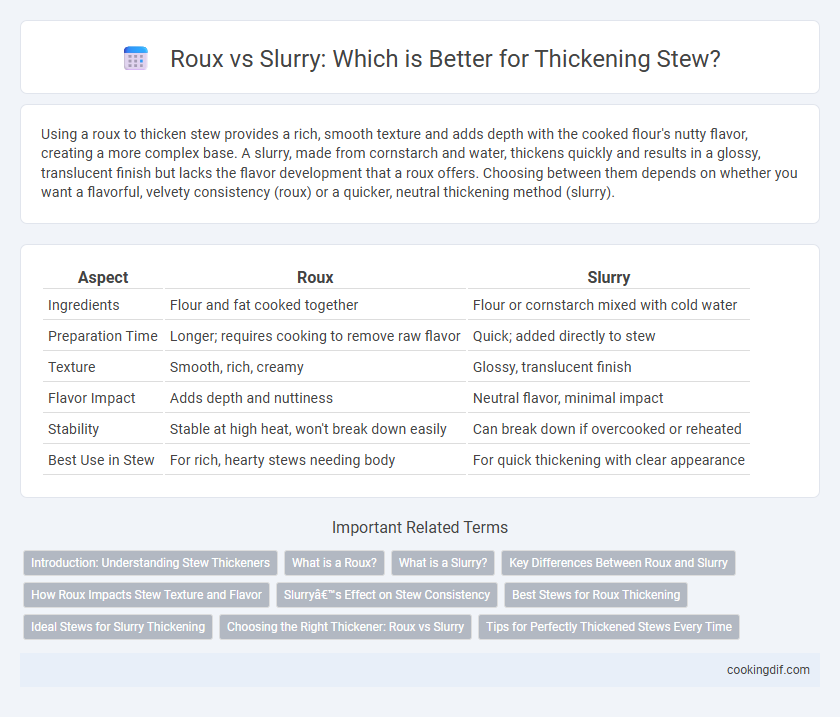Using a roux to thicken stew provides a rich, smooth texture and adds depth with the cooked flour's nutty flavor, creating a more complex base. A slurry, made from cornstarch and water, thickens quickly and results in a glossy, translucent finish but lacks the flavor development that a roux offers. Choosing between them depends on whether you want a flavorful, velvety consistency (roux) or a quicker, neutral thickening method (slurry).
Table of Comparison
| Aspect | Roux | Slurry |
|---|---|---|
| Ingredients | Flour and fat cooked together | Flour or cornstarch mixed with cold water |
| Preparation Time | Longer; requires cooking to remove raw flavor | Quick; added directly to stew |
| Texture | Smooth, rich, creamy | Glossy, translucent finish |
| Flavor Impact | Adds depth and nuttiness | Neutral flavor, minimal impact |
| Stability | Stable at high heat, won't break down easily | Can break down if overcooked or reheated |
| Best Use in Stew | For rich, hearty stews needing body | For quick thickening with clear appearance |
Introduction: Understanding Stew Thickeners
Roux and slurry are two primary thickeners used to achieve the ideal consistency in stew. Roux, made from equal parts fat and flour cooked together, imparts a rich, velvety texture and depth of flavor. Slurry, typically consisting of cornstarch or flour mixed with cold water, provides a quicker, more neutral thickening effect without altering the stew's taste.
What is a Roux?
A roux is a classic thickening agent made by cooking equal parts of flour and fat, typically butter, until it reaches a desired color from pale blond to rich brown. This mixture not only thickens stews but also adds depth and a nutty flavor, enhancing the overall taste profile. Unlike a slurry, which relies on uncooked starch mixed with liquid, a roux undergoes cooking to remove the raw flour taste and to develop complex flavors.
What is a Slurry?
A slurry is a mixture of cold water and a starch such as cornstarch or flour used to thicken stew by adding it gradually to the hot liquid, preventing lumps. Unlike roux, which is cooked fat and flour, a slurry thickens quickly without altering the stew's base flavor or color. It offers a convenient, quick-thickening method ideal for clear or delicate stews needing a smooth, glossy finish.
Key Differences Between Roux and Slurry
Roux and slurry serve as essential thickening agents for stew, with roux made from equal parts fat and flour cooked together, providing a rich, nutty flavor and a smoother texture. Slurry consists of a mixture of cold water and cornstarch or flour added directly to the stew, offering a quicker and more neutral taste thickening without altering the base flavor. The key difference lies in roux requiring cooking time to develop flavor and color, while slurry thickens instantly but may result in a slightly translucent finish.
How Roux Impacts Stew Texture and Flavor
Roux, a mixture of flour and fat cooked together, deeply enhances stew texture by creating a rich, velvety consistency that coats ingredients evenly. Unlike slurry, roux adds a nutty, toasted flavor from the browning process, enriching the stew's complexity and depth. This method also contributes to a more stable, long-lasting thickness, making the stew luscious without the risk of separation or graininess.
Slurry’s Effect on Stew Consistency
Slurry, typically made from cornstarch and cold water, thickens stew quickly and creates a smooth, glossy texture without altering the flavor significantly. Unlike a roux, slurry adds minimal color and allows for precise control over the stew's viscosity by adding it gradually. When incorporated properly, slurry enhances stew consistency by producing a clear, evenly thickened broth ideal for light or delicate dishes.
Best Stews for Roux Thickening
Roux is ideal for hearty stews like beef bourguignon and gumbo due to its rich, velvety texture and deep flavor absorption. Unlike slurry, roux provides a stable, glossy consistency that enhances long-simmered meats and vegetables without diluting the dish. Stews with robust ingredients benefit from roux's slow-cooked flour and fat base, which develops complexity and thickens evenly.
Ideal Stews for Slurry Thickening
Slurry thickening is ideal for vegetable-based and lighter stews where a clear, glossy finish is desired without altering the stew's original flavor. It works best in slow-cooked dishes like chicken stew or seafood gumbo, providing quick thickening and easy texture control. This method preserves delicate ingredients and avoids the rich, buttery notes that a roux imparts.
Choosing the Right Thickener: Roux vs Slurry
Choosing the right thickener for stew depends on the desired texture and flavor profile. Roux, made from cooked flour and fat, imparts a rich, velvety consistency and deepens the stew's flavor, ideal for slow-cooked dishes. Slurry, a simple mixture of cold liquid and starch like cornstarch or potato starch, offers a quicker, clearer thickening effect without altering the stew's taste, making it suitable for lighter or faster preparations.
Tips for Perfectly Thickened Stews Every Time
Roux and slurry serve distinct roles in thickening stew, with roux offering a rich, nutty flavor through slow cooking of flour and fat, while slurry, a simple mixture of cornstarch and water, provides a quick, clear thickening effect without altering taste. For perfectly thickened stews, gradually whisk the roux into hot liquid to avoid lumps, or stir slurry slowly into simmering stew to achieve a smooth consistency. Precise temperature control during thickening and allowing the stew to rest off heat help achieve optimal texture and flavor integration.
Roux vs slurry for thickening stew Infographic

 cookingdif.com
cookingdif.com